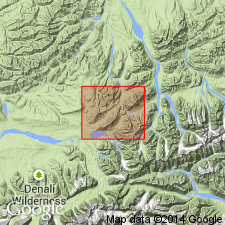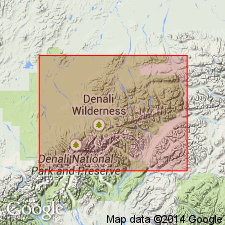
- Usage in publication:
-
- Mount Galen Volcanics
- Modifications:
-
- Named
- Dominant lithology:
-
- Breccia
- Tuff
- Andesite
- Basalt
- AAPG geologic province:
-
- Alaska Southern region
Summary:
Type locality designated as narrow ridge extending from Stony Creek, southwest to top of Mount Galen in Mount McKinley National Park, Mount McKinley B-1 quad, west central Alaska Range, AK. Rocks formerly part of Cantwell Formation (Reed, 1961). Consists of andesitic and basaltic lava flows, breccia, and tuff that covers more than 25 sq km in band from Thorofare River to point 4 km east of Stony Creek. Thickness is over 1,000 m. Unconformably overlies Cantwell Formation. As possible eruptive center, cuts Triassic(?) metabasalt. Conformably underlies Tertiary lignite-bearing sedimentary rocks. Is late Eocene and early Oligocene age on basis of range of K-Ar ages of 43.2 +/-2.6 Ma (on hornblende andesite) to 32.3 +/-1.0 Ma (on plagioclase from basalt).
Source: GNU records (USGS DDS-6; Menlo GNULEX).

- Usage in publication:
-
- Mount Galen Volcanics*
- Modifications:
-
- Overview
- Geochronologic dating
- AAPG geologic province:
-
- Alaska Southern region
Summary:
[Study area is] in the southern part of the Mount McKinley quadrangle along the east and west sides of Foraker Glacier, the west side of the Muldrow Glacier terminus, and in the vicinity of Mount Galen (fig. 2). All of these rocks were mapped by Reed (1961) as part of the Cretaceous Cantwell Formation. The volcanic rocks of the Mount Galen area were shown to be late Eocene and early Oligocene and were named the Mount Galen Volcanics by Decker and Gilbert (1978). Published K-Ar ages (Decker and Gilbert, 1978) for the Mount Galen Volcanics (table 1) range from 38.7 +/-1.1 to 41.2 +/-1.2 Ma, with minimum ages of 34.8 +/-1.4 to 39.6 +/-1.2 Ma. The new 40Ar/39Ar-plateau age of 42.8 +/-0.5 Ma reported here for a basaltic andesite flow 46 m above the base of the Mount Galen Volcanics (sample GA1-46, tables 1-3) more precisely confirms a late Eocene age for the onset of Mount Galen volcanism. On the basis of the K-Ar ages reported by Decker and Gilbert and geochemical correlations of the present study, [the authors] concur with Decker and Gilbert that the volcanic rocks of the Muldrow Glacier area correlate with the Mount Galen Volcanics and are part of the late Eocene and early Oligocene group of rocks. The base of the volcanic sequence in the Muldrow Glacier area is not exposed, but in the Mount Galen area the volcanic rocks unconformably overlie interbedded sandstone and shale of the lower part of the Cantwell Formation.
Reference cited: J.C. Reed, Jr., 1961, "Geology of the Mount McKinley quadrangle, Alaska," USGS Bull. 1108-A, 36 p., scale 1:250,000.
Source: Publication.
For more information, please contact Nancy Stamm, Geologic Names Committee Secretary.
Asterisk (*) indicates published by U.S. Geological Survey authors.
"No current usage" (†) implies that a name has been abandoned or has fallen into disuse. Former usage and, if known, replacement name given in parentheses ( ).
Slash (/) indicates name conflicts with nomenclatural guidelines (CSN, 1933; ACSN, 1961, 1970; NACSN, 1983, 2005, 2021). May be explained within brackets ([ ]).

